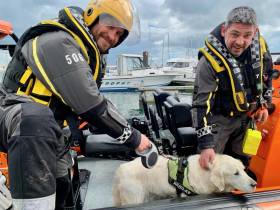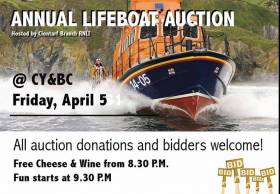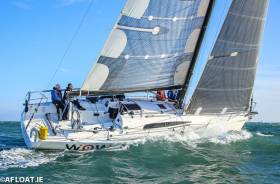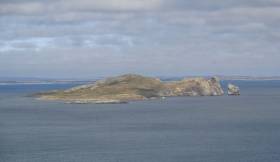Displaying items by tag: Howth
Howth Harbour Is Getting Its Own Seabin Next Week
A campaign to raise funds for Howth Harbour’s first Seabin has been successful, and the first device will be switched on at a special event next Wednesday morning (21 August).
Earlier this year, local man Rowan Byrne launched a crowdfunding drive to pay for the installation of the surface water cleaning device that has already made a big difference in Dun Laoghaire thanks to the sterling efforts of young marine litter campaigner Flossie Donnelly.
Byrne has also been backed by his employer Mott MacDonald and Howth’s Harbour Master in his own efforts, and harbour authorities will maintain the Seabin that will be installed at the passenger vessel ferry pontoon opposite Aqua restaurant.
The Seabin is essentially a floating bucket with a pump that sucks in debris from the surface and traps it for later collection.
But the device’s simplicity belies its effectiveness, as a single Seabin as the potential to collect as many as 20,000 plastic bottles or more than 80,000 plastic bags from the water each year.
“Everyone knows just how important the sea and the marine life in there is to us,” said Harbour Master Harold McLoughlin. “We hope this Seabin will have a big impact on the amount of rubbish floating around in the local area.”
Yesterday afternoon (Sunday 19 May) the Irish Coast Guard’s Howth unit was diverted from exercise to rescue two people and a dog who were cut off by the rising tide.
The crew immediately responded and began a search for the casualties who were were quickly located, taken aboard the boat and returned to a safe location ashore.
“The callers did the right thing when they realised they were in trouble: they called 112 and asked for the coastguard,” said Howth Coast Guard in a statement.
The Irish Coast Guard issued a reminder for people to be careful walking on shorelines in fine weather, as tides can rise quickly and cut one off from the shore faster than expected.
If you find yourself in this situation, immediately call 112 or 999 and ask for the coastguard.
Last weekend saw the running of the increasingly popular Investwise and CH Marine sponsored Irish Laser Masters National Championships, which took place at Howth Yacht Club, a stunning setting for the event. The event has been running since 1982, where the first Nationals was held in Dunmore East. Most notable this year was the significant increase in the Radial Fleet. A fleet of 40 boats split between Radial and Standard Rigs competed. All sailors in the Masters Fleet are 35 years of age or older. The Radials consisted of all visitors bar one as the host club has no real Master Radial fleet yet. However, with local adult Radial fleets on the increase up and down the country, next year should see in excess of twenty Radials at this event.
 Laser Masters racing at Howth
Laser Masters racing at Howth
The fleet was greeted by superb Howth weather; sunshine, blue skies, breeze and even some white horses. The race course was set up promptly and racing was underway as scheduled- the radials being particularly well behaved on each start line! There was great racing throughout the fleet on both days in the varying conditions.
Remember the fable about the Hare and the Tortoise…. Well, that was the story of first race in the Standard Fleet! The Hare was the whole fleet of Laser Sheep who missed the last mark and the Tortoise was one experienced Joe Cull – Laser Grandmaster – who probably recorded one of the biggest winning margins, before the rest of the Laser sheep realised their mistake! Grandmaster trophy sealed by 70-year-old Joe Cull in one move!
Racing was extremely tight in the Standard Rig fleet with up to 8 boats overlapped at leeward marks vying for the lead. After 3 races in mixed and testing conditions on the first day, Nick Walsh [Cork] lead the fleet. The very competitive on the water racing had 3 different race winners and 6 Laser masters still within reach of the title, at the end of day one.
"In the Radial fleet, three different race winners on Saturday set the scene for competitive racing"
In the Radial Fleet, three different race winners on Saturday set the scene for competitive racing with Darrell Reamsbottom and Conor Clancy taking race wins after Sean Craig took the opener. Difficult conditions ensued as the breeze eased throughout the day leaving an unpleasant chop. Judy O’Beirne laid down a marker for the keenly contested Ladies award with a good 5th in race 3. Peter Hassett performed well this weekend with all top 4 results and might have been second except for some pilot error in race 2!
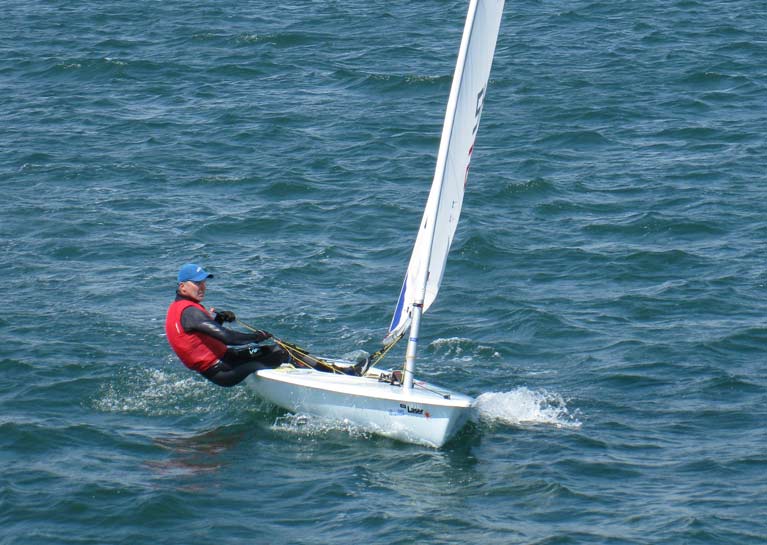 Radial Fleet winner, Sean Craig
Radial Fleet winner, Sean Craig
Back on shore the social side kicked off in good spirits. After all, the Masters is much more than just sailing! Some thirsty sailors gathered for an Investwise sponsored Hope beer drinks reception and racing debrief given by Ronan Wallace. Onboard trackers were used, showcasing our gains and losses (even one capsize!) with much slagging between the Standard rigs and Radials, but especially highlighting Standard Rigs missing the black mark in race 1! This was followed by a delicious meal in the magnificent setting of HYC dining room with the rugby on a large screen.
Sunday provided more wind than expected, with 15-20kts on the race course, enough to cause a few aches and pains by the evening! Here the Radial rig really came into its own! Two good hard races and Sean Craig and Marco Sorgassi had a ding-dong up-front before Craig pulled away in each. Craig only had a two point margin from Reamsbottom on three best results going into the final race and was keeping a very close eye on him, especially with that local knowledge. Sean Flanagan had a better second day showing the Grand Masters (Over 55s) can still do it! Philip Doherty from Cork came through well in the stronger conditions also.
Craig retained his title from 2018 showing his superior speed in true style with a very tight finish for 2nd, 3rd and 4th with Reamsbottom next, then Sorgassi, just edging out the unlucky Clancy. In the Ladies, Judy O’Beirne took the laurels showing her Frostbiting and recent training have paid off. Flanagan took first Grand Master.
In the Standard Rig, great consistency paid for David Quinn [Howth] as he sealed the title, counting 3 2nds and a 3rd, in some very close racing. With positions changing nearly every leg in the final two races he used his local knowledge and showed great ability along with experience to come out on top. Nick Walsh settled for 2nd and Dan O’Connell [Dun Laoghaire] hiked his way into 3rd overall.
Let’s just say the unnamed ‘Lead Hare’ continued his form [he got the 2 bullets in the last 2 races!] and used his local knowledge to sail onto the sandbank on the way back home…. At least most of the sheep learned and didn’t follow this time…!!!
Thanks to the excellent Race Officer, Harry Gallagher and his team of mark layers, Jim McMahon who ran launching and recovery on the slipway, the sponsors, Investwise and CH Marine, and finally to Dave Quinn for organising a superb event with great attention to detail.
Report by Shirley Gilmore and Ross O'Leary
 Dan O'Connell, 3rd Standard Rig (left) with HYC Commodore Ian Byrne
Dan O'Connell, 3rd Standard Rig (left) with HYC Commodore Ian Byrne
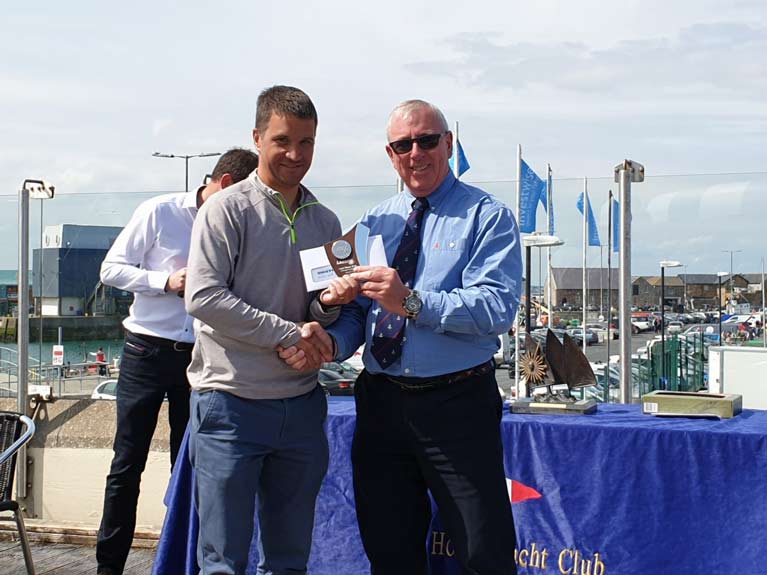 Darrell Reasmbottom 2nd Radial
Darrell Reasmbottom 2nd Radial
 Joe Cull Grand Master Standard Rig Winner
Joe Cull Grand Master Standard Rig Winner
 Marco Sorgassi, 3rd Radial
Marco Sorgassi, 3rd Radial
 Sean Flanagan, 1st Grand Master, Radial Fleet
Sean Flanagan, 1st Grand Master, Radial Fleet
 Sean Craig, Winner Radial Fleet
Sean Craig, Winner Radial Fleet
 Dave Quinn with the Standard Trophy
Dave Quinn with the Standard Trophy
Footnote:
Irish Laser Masters is probably one of the fastest growing fleets that provide a great standard of racing for all levels and abilities from 35 years +. Family friendly it is a great way to get on the water, try to stay fit and enjoy your sailing with this very sociable bunch… most sailing clubs have a local fleet and the ILA are providing training support if you want to grow the fleet in your area for all ages and abilities…more information contact [email protected]
Friday night is sure to be a winner on Dublin Bay as Clontarf Yacht & Boat Club hosts its annual auction night in aid of the Howth RNLI lifeboat tonight, Friday 5 April.
Gary Sargent and Elaine Ball will host the auction from 9.30pm with many items up for bidding, including vouchers for Irish Ferries and Stena Line.
The CY&BC also invites attendees to bring along their own items for auction to raise finds for the lifesaving charity.
Complimentary wine and cheese will be served for those who come early from 8.30pm.
Planning Hearing On Clonshaugh Wastewater Plant Gets Under Way
Planners are from today set to review proposals for a controversial €500 million wastewater treatment scheme in North Dublin, as The Irish Times reports.
Clonshaugh near Dublin Airport was chosen in June 2013 as the site for the sewage ‘super plant’ before Irish Water took over the Greater Dublin Drainage project from Fingal County Council last year.
The new plant — second only to the Ringsend wastewater facility in scope — would be connected to a new orbital sewer to Blanchardstown, and an outfall pipe to eject treated wastewater in the sea north of Ireland’s Eye.
Plans for the new sewage processing plant have faced strong local opposition, both from residents adjacent to the Clonshaugh site and connected works and marine professionals concerned about potential environmental risks.
Last October, Howth-based ferryman Ken Doyle expressed his fears of the knock-on effect on fish stocks from any accidental contamination of the local waters from the outfall pipe.
The planning hearing began at The Gresham hotel in Dublin this morning, and The Irish Times has more on the story HERE.
Crowdfunding Campaign Launched For Howth’s First Seabins
#Seabin - Howth will be the latest Irish port to benefit from a revolutionary device designed to clean up harbour and marina waters.
Independent.ie reports that local man Rowan Byrne has launched a crowdfunding campaign to pay for the installation of two Seabins in the north Co Dublin harbour.
Byrne notes how more and more people at home and beyond are discovering Howth’s natural beauty, but that this also means “more and more plastics, nano, micro and macro plastics are seen floating on the waters surface in the harbour”.
One solution to this problem is the Seabin — a floating bucket with a pump that sucks in surface debris and traps it for collection.
A single device has the potential to collect as many as 20,000 plastic bottles or more than 80,000 plastic bags each year.
Byrne’s efforts follow those of young marine litter campaigner Flossie Donnelly, who recently presented the National Yacht Club with its own Seabin — the second such device in Dun Laoghaire Harbour after her own crowdfunded bin was installed last summer.
Ards and North Down Borough Council is also seeking to procure a number of Seabins to help clean up the coastline of the Ards Peninsula around Strangford Lough.
The Zest is Back in Irish Sailing
Maybe it’s the fact that the days start to get longer again in only a fortnight, but there’s mood of rising optimism in Irish sailing these days writes W M Nixon. There’s an almost measurable buzz in the air which is spearheaded by the pace-setting Fintan Cairns-inspired DBSC Turkey Shoot Series in Dublin Bay, and given substantial extra boosts by long-established Autumn and Winter series going full blast at other centres.
This fresh zest for our sport is supported by more traditionally-minded sailors. They may have preferred to bring their season to a close in October or November with their boats properly laid up for the winter, but the amount of work they have going on behind the scenes to get new initiatives up and running, while keeping existing programmes in good and growing health, is a remarkable reflection on the value of the voluntary effort and input which sailing inspires.
 The Man Who Makes It Happen – Fintan Cairns, main driver of DBSC’s Turkey Shoot series
The Man Who Makes It Happen – Fintan Cairns, main driver of DBSC’s Turkey Shoot series
As one leading big-boat contender in the Turkey Shoot has put it: “If it wasn’t for the continuing enthusiasm of Fintan and his team chivvying us out there every Sunday morning, and then being on station with the Committee Boat to set another excellent course, then I don’t think half of us would think of taking part in a series which takes us right up to the very threshold of Christmas. Yet here it is, week after week for seven Sundays with a splendidly varied fleet of 75 boats, and the mood is euphoric – it feels like the best racing we’ve had all year, and it probably is”.
The regular reports in Afloat.ie give some idea of the pace of the sport and the calibre of the racing, yet although there are so many relatively new contenders involved that it has been commented that the Turkey Shoot 2018 is for all the world like a live Boat Show afloat and racing, it’s somehow reassuring to note that going into this weekend’s race, the overall leader is Sean O’Regan’s vintage Dehler 31 Vespucci.
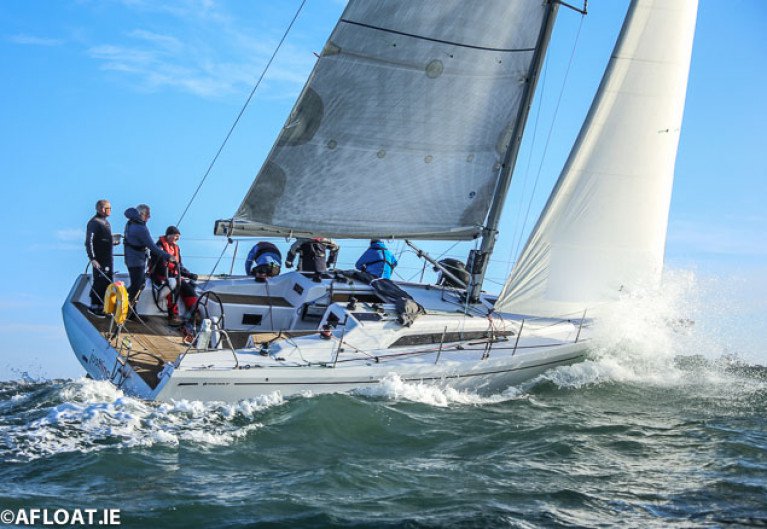 “Making mince of the Dublin Bay chop” – John Treanor’s new Grand Soleil 34 Justitna. Photo: Afloat.ie/David O’Brien
“Making mince of the Dublin Bay chop” – John Treanor’s new Grand Soleil 34 Justitna. Photo: Afloat.ie/David O’Brien
That said, if we were to choose a “Marque of the Year” in Irish sailing, the Grand Soleil brand from Italy would definitely be on the shortlist, with John Treanor’s new Grand Soleil 34 Justtina turning many heads in the Turkey Shoot as she makes mince of the Dublin Bay chop.
Through the season, Frank Whelan’s Grand Soleil 44 Eleuthera from Greystones set the pace on both the east and south coasts, while on the south coast the Murphy family’s Grand Soleil 40 Nieulargo rounded out a great season by being made the Royal Cork YC’s “Keelboat of the Year”.
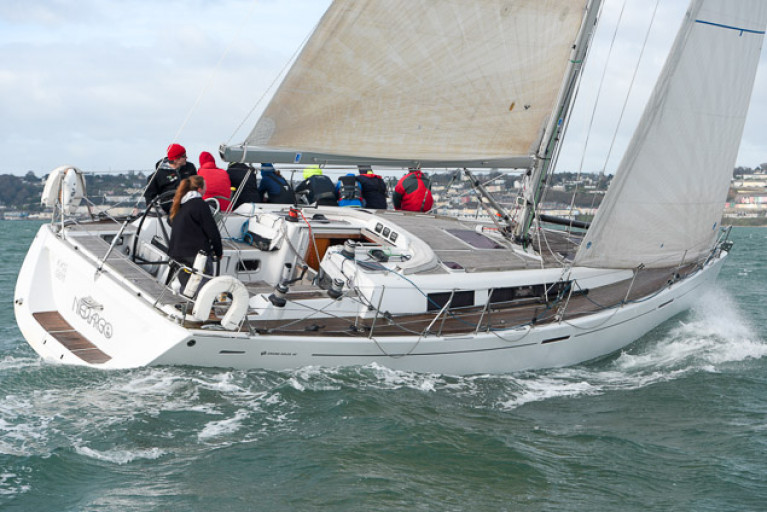 Classy performer – the Murphy family’s Grand Soleil 40 Nieulargo brings teak deck style to the front of the fleet. Photo: Bob Bateman
Classy performer – the Murphy family’s Grand Soleil 40 Nieulargo brings teak deck style to the front of the fleet. Photo: Bob Bateman
Still on the south coast, as our colleague Tom MacSweeney was reporting, the recent AGM of the South Coast Offshore Racing Association brought a breath of fresh air with the much-approved election of Johanna Murphy of Great Island SC as the first woman sailor to be Commodore. She takes up the role with a clear vision of encouraging coastal passage races, but as such races have to be fitted in with the increasing number of club At Homes, the demand on premium dates is high.
A further challenge was added to the brew at the AGM with a significant presence from Waterford Harbour SC at Dunmore East, seeking to have their historic yet expanding club included in the SCORA programme. This is quite a challenge, as it’s all of 50 nautical miles and more from Cork Harbour to Dunmore East. That’s fine and dandy if the SCORA main fleet race there from Cork Harbour with a grand following breeze, but problems of logistics arise when they face the uphill slog home.
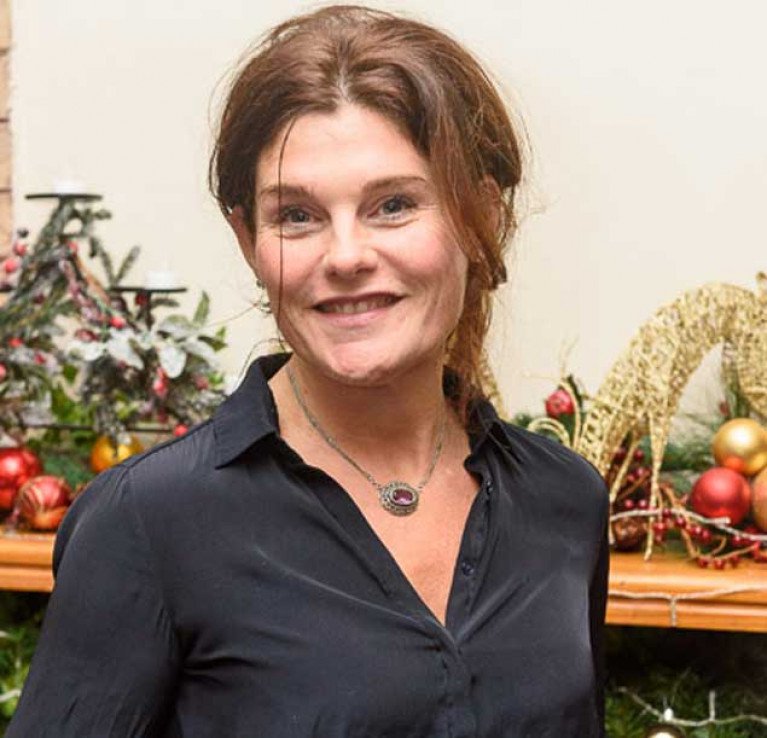 Early Christmas present for Johannna Murphy of Cork Harbour’s Great Island SC – she’s the new Commodore of the South Coast Offshore Racing Association. Photo: Bob Bateman
Early Christmas present for Johannna Murphy of Cork Harbour’s Great Island SC – she’s the new Commodore of the South Coast Offshore Racing Association. Photo: Bob Bateman
Nevertheless in due course there’s no doubt Dunmore East will be back in the offshore racing picture, just as in due course a fleet of J/109s has developed in Dublin Bay as everyone hoped for years would eventually happen. And not only is God in his heaven with ace MOB rescuer Tim Goodbody in the lead in White Mischief in the J/109s racing in the Turkey Shoot, but this week it has been revealed that the latest addition to the class is newly-elected ICRA Commodore Richard Colwell, back in harness with his former longtime campaigning partner Johnny Murphy with their recently-acquired J/109 Outrajeous. They’ll be keeping her at their home port of Howth, increasing the likelihood of further sister-ships there, as they’ll be joining Colm Buckley and Simon Knowles with Indian, and the daddy of them all, Pat Kelly with the all-conquering Storm.
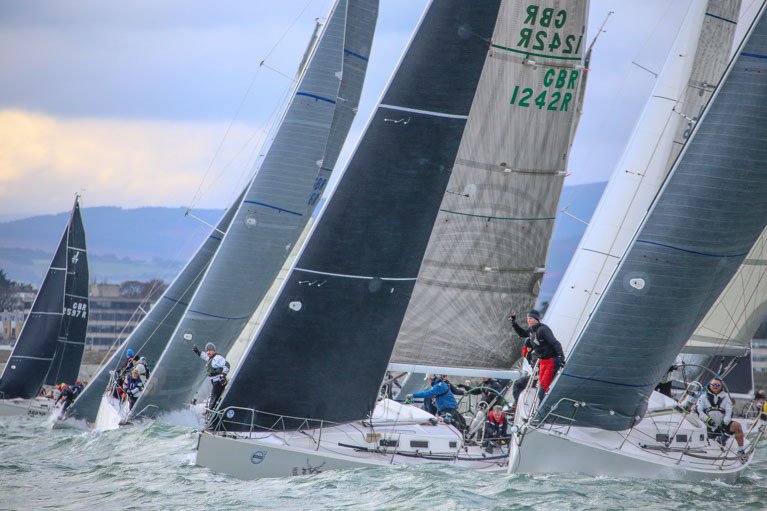 Tim Goodbody’s White Mischief gets the best of a J/109 start in the Turkey Shoot series. The class is extending its reach with Outrajeous (Richard Cowell & Johnny Murphy) joining the pair in Howth. Photo: Afloat.ie/David O’Brien
Tim Goodbody’s White Mischief gets the best of a J/109 start in the Turkey Shoot series. The class is extending its reach with Outrajeous (Richard Cowell & Johnny Murphy) joining the pair in Howth. Photo: Afloat.ie/David O’Brien
Howth, with its winter Laser Frostbites dating from 1974 and its keelboats Brass Monkey series now in its 32nd year, continues to be a hive of activity. In fact if anything the colourful sailing/fishing harbour as a whole had a problem of success, as it has become such a visitor magnet that, on a good weekend, the quaysides and waterfront roads can get distinctly crowded.
A series of fortuitous circumstances have brought about the situation whereby the place can offer such an attractive visitor experience. When the harbour was undergoing its massive re-development in the 1980s, the original plan was that all the ancient and often quaint buildings of the West Pier should be swept away to provide the maximum of space for fishing-related work and vehicle movements. But by some miracle they all were saved, and today the colourful line of buildings down the West Pier is home to more popular and varied seafood restaurants than you could count, cheek-by-jowl with marine industry workshops. And the old Mariner’s Hall, originally built as “The Prayer House” for visiting Scottish fishermen, has been saved from demolition and is currently having its roof replaced with such attention to detail that its woodwork will become a special architectural feature.
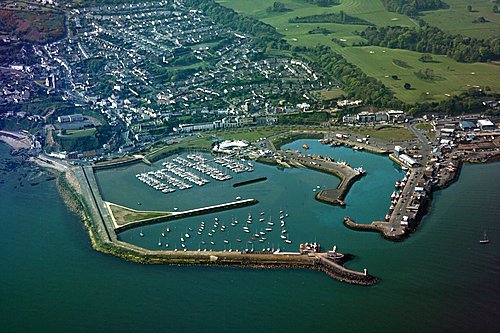 Howth’s complex and often very busy harbour. Its necessary dredging has now been recognised as a Major Infrastructural Project
Howth’s complex and often very busy harbour. Its necessary dredging has now been recognised as a Major Infrastructural Project
But while everything above the water around Howth’s increasingly tidy yet ever busier harbour seems to be going fine, under the sea’s surface things aren’t so good, as bits of the harbour badly need dredging. In the Netherlands where they’re the world leaders in building and maintaining maritime structure, all harbours are automatically dredged every five years at least. But in Howth although the harbour as we know it now dates back to 1982, there has been only piecemeal dredging and channel clearance, and a major infrastructural project is on the cards.
With this in mind, leading Howth fisherman Sean Doran and local Senator Catherine Noone and others set about arranging a top level visit which would bring Howth’s problems home to Government at the highest level. They reckoned that the case would be best put if the Government could meet representatives of all the harbour stakeholders in an effort to gauge how much could be maintained and added to local economic activity by bringing the harbour depths up to the required standards.
 Taoiseach Leo Varadker with Howth YC Commodore Joe McPeake in the clubhouse last weekend. Photo: HYC/Brian Turvey
Taoiseach Leo Varadker with Howth YC Commodore Joe McPeake in the clubhouse last weekend. Photo: HYC/Brian Turvey
It’s only when you set out to arrange such a gathering that you become fully aware of how many revenue-generating and employment activities a harbour as diverse as Howth can encompass. When local TD and Government Minister Richard Bruton and Senator Noone set out last Saturday afternoon with Fingal Mayor Councillor Anthony Lavin to show Taoiseach Leo Varadkar round Howth Harbour and meet the people who make it work, it was one busy day, with harbourmaster Captain Harry McLoughlin and others taking the fact-finding group on a mission which started with the many fishing enterprises and the shore facilities for the regular summer ferry route to Dublin and Dun Laoghaire, went on with a wide variety of retail and workshop outfits, seemed to take in everything possible to improve the harbour, and then concluded with a much-needed cup of tea in Howth Yacht Club where Commodore Joe McPeake and his team were able to introduce the Taoiseach to sailors at every level from absolute beginners to Olympic 49er Under 23 Gold Medallists Robert Dickson and Sean Waddilove, while at the same time providing information about how Howth YC’s Quest Sailing School is reaching out to people from every background.
 In Howth YC are (left to right) 49er Under 23 Gold Medallist Robert Dickson, Mayor of Fingal Councillor Anthony Lavin, Taoiseach Leo Varadker, Senator Catherine Noone, Gold Medallist Sean Waddilove and HYC Commodore Joe McPeake, with Richard Bruton TD, Minister for Communications, Climate Action and Environment also in photo. Photo: HYC/Brian Turvey
In Howth YC are (left to right) 49er Under 23 Gold Medallist Robert Dickson, Mayor of Fingal Councillor Anthony Lavin, Taoiseach Leo Varadker, Senator Catherine Noone, Gold Medallist Sean Waddilove and HYC Commodore Joe McPeake, with Richard Bruton TD, Minister for Communications, Climate Action and Environment also in photo. Photo: HYC/Brian Turvey
It was a mutually informative yet pleasantly informal gathering, sweetened by the news that the dredging of Howth Harbour is now agreed as a Major Infrastructural Project. And for any busy yacht or sailing club to be given this opportunity to see itself as others see it, and to see particularly how well - with mutual goodwill - it fits in and interacts with the community around it, well, that was a real tonic for the membership.
But then, having been at the annual dinner of the historic Howth Seventeen Foot Class in the clubhouse the night before, your correspondent was already reassured about the basic good health of HYC. For this might well have been the 120th Annual Dinner of the Howth Seventeens, as they were founded in 1898. But with a convivially packed house with 128 present, the mood was so youthful it could have been the first Annual Dinner of all, for age shall not weary them.
 “Age shall not weary them….” The Howth 17s held what may well have been their 120th Annual Dinner last weekend, but as they know they were founded in 1898, nobody has been counting. Photo: W M Nixon
“Age shall not weary them….” The Howth 17s held what may well have been their 120th Annual Dinner last weekend, but as they know they were founded in 1898, nobody has been counting. Photo: W M Nixon
And even when it does, the Seventeens have a remarkable capacity for renewal, headed in the 1970s by Nick Massey, and more recently kept simmering by Ian Malcolm. Their capacity for re-birth is extraordinary, and thus the Howth Seventeen people are among the most appreciative of a small beautifully-restored yacht which quietly appeared in their marina back in September.
This is the 23ft Laurent Giles-designed L Class Iduna, originally built in 1938 and bought in 1948 by the late Roger Bourke of Limerick and Foynes. Iduna is now owned by his son Robert for whom she has been restored by Howth master-shipwright Johnny Leonard, who is indeed connected to the great County Cork boat-building clan.
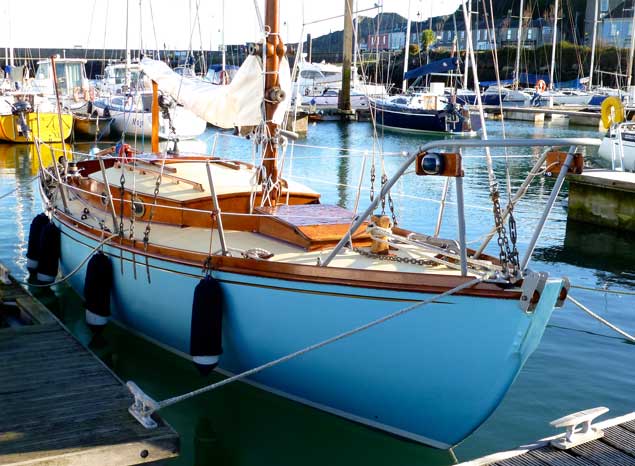 The restored 80-year-old Iduna, brought to new life by Johnny Leonard of Howth. Photo: W M Nixon
The restored 80-year-old Iduna, brought to new life by Johnny Leonard of Howth. Photo: W M Nixon
Iduna, as restored by those Leonard skills, simply glows – there’s no other word for it. And in time when finishing jobs have been completed, she’ll be based in Dun Laoghaire though her home port will always be Foynes, as her owner moves between bases in Limerick and Dublin. But for now, she’s an adornment in Howth marina, and anyone feeling the winter glooms only has to go and look at her to feel better.
In fact, the health benefits of seeing a good boat restoration cannot be underestimated, and down West Cork way they almost have a regional service in this feel-good factor, what with Ilen being restored at Oldcourt where Saoirse is now being re-built, while across at Ballydehob, Tiernan Roe has the fine job of restoring The Lady Min underway for the O’Keeffe family of Schull, and nearby Rui Ferreira – already well proven in classic boat restoration and new-build - has Dublin Bay Water Wag No 49 under new construction for Martin Byrne.
 Rui Ferreira of Ballydehob with the new Water Wag, no 49 to a design from 1900. Photo: Ian Malcolm
Rui Ferreira of Ballydehob with the new Water Wag, no 49 to a design from 1900. Photo: Ian Malcolm
This is being done to such an exquisite standard that you’d think she should be put straight into a glass case for permanent display purposes. Between all these restorations and new-build projects, together with the good news about re-vitalised sailing enthusiasm and increased government awareness of harbour needs, there’s a fresh zing to the sea air which launches Irish sailing towards 2019 with vigorous optimism.
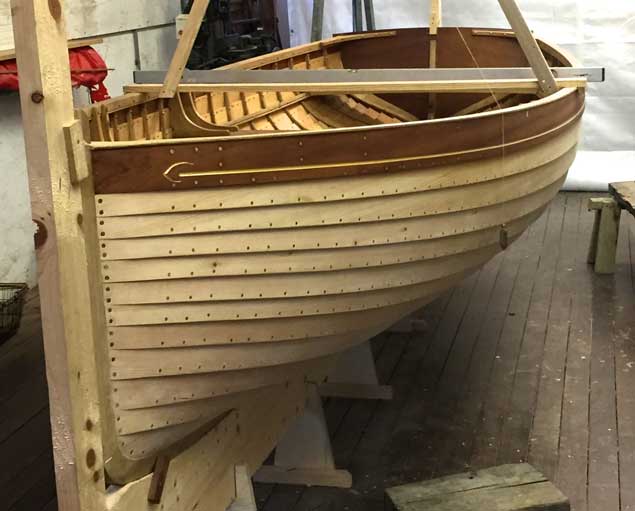 The classic Water Wag, designed 118 years ago by Maimie Doyle, daughter of boatbuilder James Doyle. Photo: Ian Malcol
The classic Water Wag, designed 118 years ago by Maimie Doyle, daughter of boatbuilder James Doyle. Photo: Ian Malcol
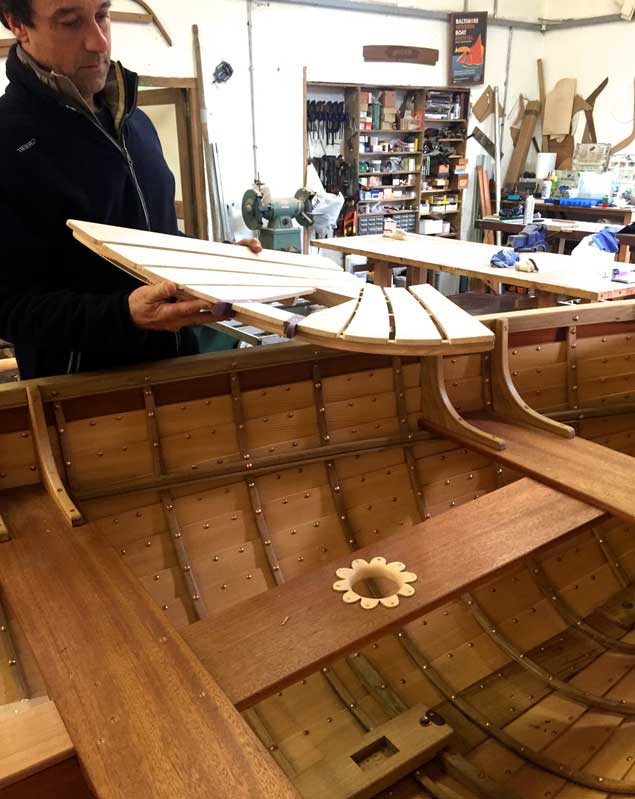 Rui Ferreira is renowned for his attention to detail in classic boat-building, and with Water Wag 49 he has excelled himself. Photo: Ian Malcolm
Rui Ferreira is renowned for his attention to detail in classic boat-building, and with Water Wag 49 he has excelled himself. Photo: Ian Malcolm
#MarineWildlife - A Howth-based ferryman fears for marine wildlife on and around Ireland’s Eye when a planned sewage outfall pipe begins discharging wastewater in the area.
Ken Doyle of Ireland’s Eye Ferries tells Dublin Live that any accidental contamination of the waters from the pipeline, from Clonshaugh to a mile off the small island immediately north of Howth, could have a disastrous knock-on effect on fish stocks — an issue both for sea anglers and local bird and seal colonies.
Five years ago, Clonshaugh in North Co Dublin was chosen as the location for the capital’s wastewater treatment ‘super plant’.
The scheme will connect a 26km orbital sewer through counties Dublin, Kildare and Meath with an outfall pipeline ejecting waste off Ireland’s Eye.
Doyle noted that when the outflow of raw sewage at Howth Head was ended with the opening of the Ringsend treatment plant, improvements in water quality meant “the bird population increased hugely and it’s all positive but I wouldn’t like it to go back to like it was.”
He adds that he is not opposed to the wastewater scheme in principle — only that he and other local residents and businesses want assurances that the plant will not have any negative impact on the environment.
Volunteers Wanted For Howth Coast Guard
#Coastguard - Howth’s Irish Coast Guard unit is looking to recruit and train three new volunteers in 2019.
If you live very locally to the North Co Dublin coastguard unit and are highly available, interested volunteers must attend an information evening at the West Pier coastguard station on Wednesday 24 October.
This meeting is mandatory if you wish to be considered for one of these three trainee positions.
To register your attendance email [email protected].
Recently Dun Laoghaire Coast Guard put out their own call for potential new volunteers to join South Co Dublin unit.
#RNLI - Minutes after participating in the local St Patrick’s Day parade on Saturday 17 March, Clifden RNLI joined a full-scale search and rescue operation for two spear divers reported missing.
Clifden’s all-weather and inshore lifeboats were tasked alongside Achill RNLI, the Sligo-based Irish Coast Guard helicopter Rescue 118 and the Cleggan Coast Guard Unit in the search for the two men that had left Rossroe pier that morning in a small inflatable boat to go spear fishing on the north side of Killary Harbour. The men had not been since that morning.
At 1.12pm, Clifden RNLI’s all-weather lifeboat Fisherman’s Friend was prepared for launch with coxswain Alan Pryce, mechanic Robert King, navigator Owen Hayes and crew members Tom Davis, Kieran Folan and David Coyne.
The D class inshore lifeboat Celia Mary was transported by road to Rossroe and was crewed by helm James Mullen and crewed by Brian Ward, David O’Reilly and Ian Shanahan. Shore crew volunteer Fergal Conneely drove the Land Rover with the inshore lifeboat in tow to launch at Rossroe pier.
Clifden’s inshore lifeboat shortly after arrived on the scene joining Rescue 118. The crew were briefed by the local fisherman who had reported the spear divers missing.
When he was out fishing about 90 minutes previously, he had seen them spear fishing on the north side of the bay with a small inflatable with an outboard engine. However, he hadn’t seen them or their inflatable since, and as their van was still on the pier, with the weather deteriorating, he decided to call for assistance.
Weather conditions had a north-easterly Force 5-6 wind as Rescue 118 were conducting an aerial search of the bay. The lifeboat crew then spotted a small inflatable with two people onboard trying to hang onto a barge.
Clifden RNLI helm James Mullen said: “I informed Rescue 118 of the possible sighting and they proceeded to the area with us. When we arrived on scene, the two men informed us that they were the two missing spear divers.
“Their engine had broken down and they had tried to swim the across the bay with their boat but it had become swamped. Their legs had cramped and they were both exhausted. We towed them back to the pier at Rossroe and helped them recover their boat at 2pm.”
Clifden RNLI lifeboat operations manager John Brittain added: “The inshore D Class lifeboat Celia Mary, which was just named in a ceremony last year, has once again proved how much of a valuable asset it is to our station.
“We are delighted to have been able to respond and bring these people to safety and are also very thankful for the vigilance of the local fisherman who raised the alarm and potentially avoided a much worse outcome today.”
Elsewhere on Saturday, Howth RNLI launched its all-weather lifeboat to reports of an upturned kayak spotted in rough seas off the nose of Howth.
A member of the public, while out walking on Howth Head, spotted what appeared to be a yellow upturned kayak just off the nose of Howth in very rough water and raised the alarm with the Irish Coast Guard, sending them a picture taken with their smartphone.
Howth RNLI was immediately tasked to investigate, with crew pagers sounding at 5.45pm and the lifeboat launched within 12 minutes. Weather conditions saw a very rough sea state in Force 6-7 easterly winds.
Despite the poor conditions, the kayak was quickly located and brought aboard the lifeboat. It looked like it had not been used for quite some time and had been adapted to support a floating structure. The lifeboat completed a search of the area and returned to base.
Speaking following the callout, Howth RNLI station mechanic Ian Sheridan said: “We have to compliment the member of the public for their quick action. While in this case it was thankfully a false alarm, the accuracy of their report to the coastguard allowed us to find the reported vessel and conduct a search.”





























